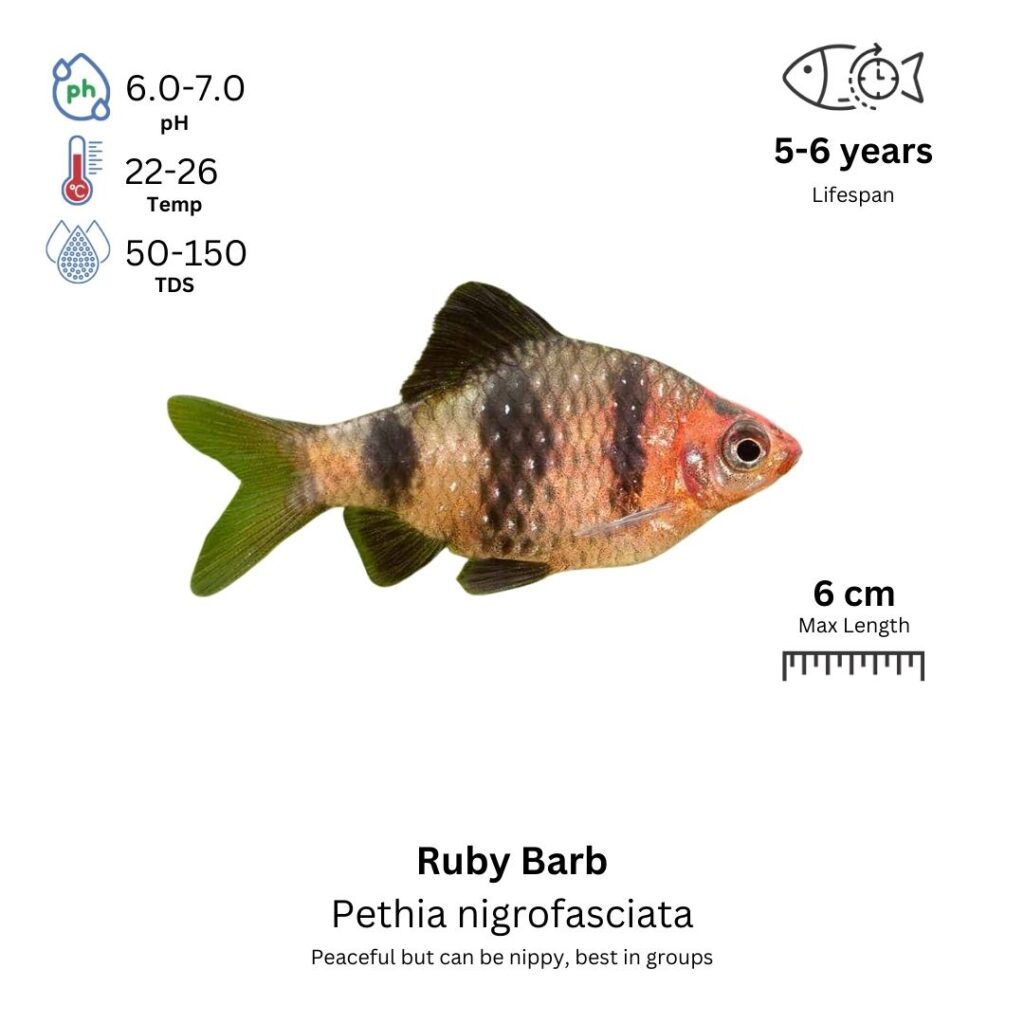Ruby Barb
Puntius everetti

Description
The Ruby Barb is a small, vibrant species of barb known for its striking ruby-red coloration, which gives it its name. The body of the Ruby Barb is slender and elongated, with a bright, deep red hue that intensifies during breeding periods, especially in males. Females are typically less vibrant, with a more subdued coloration that is still reddish but not as intense. The Ruby Barb has a smooth body and a slightly forked tail fin, contributing to its streamlined appearance.
Habitat Origin
Native to the freshwater rivers and streams of South Asia, particularly in countries like India, Bangladesh, and Pakistan. These fish are found in slow-moving or still waters with moderate vegetation, where they can forage for food. The water in their natural habitat is typically soft to slightly hard, with a neutral to slightly acidic pH. Ruby Barbs prefer well-oxygenated environments and thrive in moderately warm waters.
Aquarium
Ideal Number in Aquarium: At least 6 individuals, as they are schooling fish and feel more secure in groups.
Favorite Food

Ruby Barbs are omnivores and will accept a variety of foods. They can be fed high-quality flake food, micro pellets, and live or frozen foods such as brine shrimp, daphnia, and bloodworms. They will also graze on algae and small plant matter in the aquarium. A varied diet ensures they stay healthy and maintain their vibrant coloration.
Behavior:
Ruby Barbs are active, peaceful, and social fish that thrive in schools. They are often seen darting around in the middle to upper regions of the tank, displaying their natural schooling behavior. These fish are generally calm but may become slightly territorial during breeding. Males, in particular, can display more vibrant colors when courting females, making them an attractive addition to aquariums. They are peaceful and do well in community tanks with other small, non-aggressive species.
Special Care:
Ruby Barbs are relatively easy to care for but thrive best in stable water conditions. Regular water changes and good filtration are important to maintain water quality. They prefer a well-planted tank with plenty of open swimming space and hiding spots, such as rocks or driftwood. These fish are hardy but do best in slightly acidic to neutral water with moderate flow and well-maintained conditions.
Compatibility with Other Fish:
Yes, Ruby Barbs are compatible with many peaceful fish species. They can be housed with other small, non-aggressive species such as tetras, rasboras, and small cichlids. They are also compatible with shrimp and snails. Larger or more aggressive fish should be avoided, as they may stress or harm the Ruby Barbs. They are ideal for community aquariums, where they can coexist with other peaceful species and display their natural schooling behavior.
Breeding Tank Setup
To successfully breed Ruby Barbs, it is best to use a separate breeding tank. This setup reduces stress and eliminates interference from other fish species. A 40–50 liter (10–13 gallon) tank provides ample swimming space and makes it easier to manage water quality. Ideal water parameters include a pH of 6.0–7.5, temperature between 24–28°C (75–82°F), and soft to medium hardness (5–12 dGH). Equip the tank with a sponge filter to ensure gentle water flow that won’t disturb the eggs or fry. For substrate, use fine gravel or sand, and include Java moss, Anubias, or other fine-leaved plants where eggs can be deposited. Standard lighting with a 12-hour cycle is sufficient, but adding shaded areas through plants or decor will help reduce stress.
Conditioning for Breeding
Before spawning, condition the Ruby Barbs with a high-protein diet of live or frozen foods like brine shrimp, bloodworms, daphnia, and earthworms, supplemented with quality flakes or pellets. This will help both sexes develop well and encourage spawning behavior. Perform a 20–30% water change 1–2 days before introducing the pair to the breeding tank. Slightly raising the temperature to 28°C (82°F) can simulate natural conditions and trigger mating behavior.
Spawning Behavior
Spawning typically occurs in the early morning, especially after a water change. Males become more vibrant and chase the females as a sign of readiness. A healthy female can lay between 100 to 300 eggs per session, depending on her condition. After spawning, immediately remove the adult fish, as Ruby Barbs are known to eat their eggs. Eggs are adhesive and stick to plants or other surfaces, where they will develop undisturbed.
Fry Hatching
Eggs hatch in 2–3 days, depending on water temperature. After hatching, fry will remain near the substrate or leaves while absorbing their yolk sacs. Once free-swimming (2–3 days post-hatching), begin feeding with infusoria or liquid fry food. After a week, transition to newly hatched brine shrimp or finely crushed flakes. Maintain excellent water quality by performing 10–15% water changes every 2–3 days. Keep water temperature stable and use a sponge filter to avoid harming the delicate fry.
Final Notes & Breeding Tips
Ruby Barbs are ready to breed at around 6–12 months of age. Males are smaller, slimmer, and show brighter red and orange colors, especially during breeding. Females are rounder, particularly when gravid, and have a paler appearance. To maximize breeding success, avoid overcrowding and aggressive tankmates, and maintain stable water parameters without sudden fluctuations. Providing plenty of hiding places and spawning surfaces will help the pair feel secure and increase the likelihood of successful spawning.
